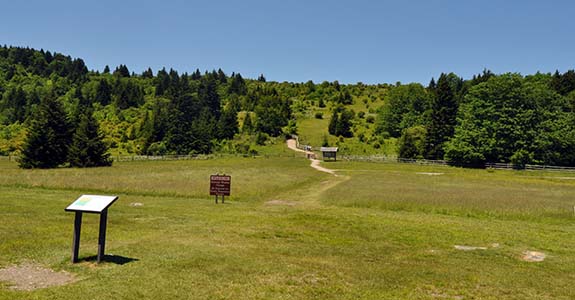
 Department of Conservation and Recreation
Department of Conservation and Recreation
Conserve. Protect. Enjoy.
 Department of Conservation and Recreation
Department of Conservation and Recreation

Virginia is blessed with a wealth of scenic landscapes unmatched anywhere else on the East Coast. Trails woven throughout these landscapes may well be the best way to experience and explore our commonwealth.
Trails allow access in many forms - by foot, bicycle, horseback or even canoe, kayak or boat. Each allows the user to enjoy his surroundings at his or her own pace. It has been said that trails are the front porch of the 21st century.
Over the past decade, the number and sophistication of community-driven trail projects has grown as has local awareness of the value of trails. Planners and enthusiasts will tout many assets and attributes of trails - their role in attracting tourists and the revenue they bring; their appeal in connecting historical, scenic and cultural resources; their utility as alternate transportation; their health value - promoting physical, mental and spiritual wellbeing.
They appeal to a wide variety of demographic groups, become community showplaces, and are important in protecting our environments and landscapes. But most important - and interestingly enough, among of their most overlooked attributes - are the joy, the fun and the recreational value they bring to local residents.
Goal 1: Enhance access to the outdoors through the development of a trails network that promotes healthy recreation and connects citizens, including children and families, to Virginia's diverse open space and natural landscapes.
Goal 2: Improve linkages between communities and key tourist destinations in both rural and urban areas to promote regional outdoor recreation and heritage tourism initiatives, support local economies, and provide economic stimulus for small-business start-ups and entrepreneurial expansion.
Goal 3: Create the foundation of a statewide system of interconnected open-space corridors through which trails traverse in order to support long-term protection of Virginia's "green infrastructure" and the ecological services it provides.
Goal 4: Integrate trails as a critical component in Virginia's transportation infrastructure in order to provide efficient and convenient non-motorized connections to neighborhoods, schools, community facilities and employment centers.
Goal 5: Educate citizens about the trail network's social, ecological, transportation and wellness benefits, and foster educational pursuits through environmental research, multicultural programs and "outdoor classrooms."
National trails are officially established under the authorities of the National Trails System Act (16 USC 1241-51). There are several types:
In addition to the Appalachian National Scenic Trail, DCR identified in its Virginia Outdoors Plan the following statewide trails.
Potomac Heritage National Scenic Trail
East Coast Greenway
James River Heritage Trail
Beaches to Bluegrass Trail
Great Eastern Trail
In addition, the state offers a variety of trail experiences on state lands. Virginia's State Parks offer more than 600 miles of trails, many of which connect to the extensive trail and gated roads system in adjacent state and national forests. High Bridge Trail State Park offers 31 miles of adventure on a former railway donated by Norfolk Southern Corporation. Norfolk Southern also donated abandoned rail corridor for New River Trail State Park, a 57-mile rail-trail stretching from Pulaski to Galax and Fries in Southwest Virginia. The Wilderness Road Trail in Lee County joins the Wilderness Road State Park with the Cumberland Gap National Historic Park. In addition to hiking trails, many parks have trails for horseback riding as well as trails designed specifically for mountain biking. In particular, the International Mountain Bike Association has specially designated the Richmond Regional Ride Center and Virginia’s Blue Ridge Regional Ride Center.
In addition, IMBA has designated several EPIC ride centers in the state, which are more than 80 percent singletrack and at least 20 miles in length, including the Southern Traverse (36 miles) and Douthat State Park (40 miles).
Virginia's Department of Transportation has a number of shared-use paths that run parallel to major roads. Since these are entirely within VDOT rights-of-way, they are built and maintained by VDOT or its partners. Many of these paths, like the one beside the Fairfax County Parkway, are located in Northern Virginia, where bicycle plans have been in place for many years. In particular, the 52-mile Virginia Capital Trail is shared-use and runs from Richmond to Jamestown along scenic and historic Route 5. Many other paths in Northern Virginia also serve as integral parts of the transportation system.
Virginia's Department of Wildlife Resources (VDWR), within its wildlife management area system, maintains numerous access trails for hunting, fishing and other wildlife-related outdoor recreation. These trails are also open for hiking and horseback riding, although it is not recommended during hunting season. The popular Virginia Birding and Wildlife Trail, a thematic driving trail that links approved sites across the state, celebrates the diversity of Virginia's natural habitat. Bear in mind that VDGIF requires those wishing to visit its wildlife management areas and public fishing lakes to first obtain an access permit.
The Virginia Department of Forestry also maintains many trails in 20 state forests. Horseback riders have recognized the potential of this system of gated roads and have worked with the state forester to build and maintain a system of horse trails in several state forests. Allowed uses vary by forest; anyone wishing to bike or ride horses on state forest trails must first obtain a state forest-use permit.
Learn more about local trails and regions promoting outdoor recreation in Virginia.
The State Trails Advisory Committee assists the Commonwealth in developing and implementing a statewide system of attractive, sustainable, connected and enduring trails for the perpetual use and enjoyment of the citizens of the Commonwealth and future generations.

